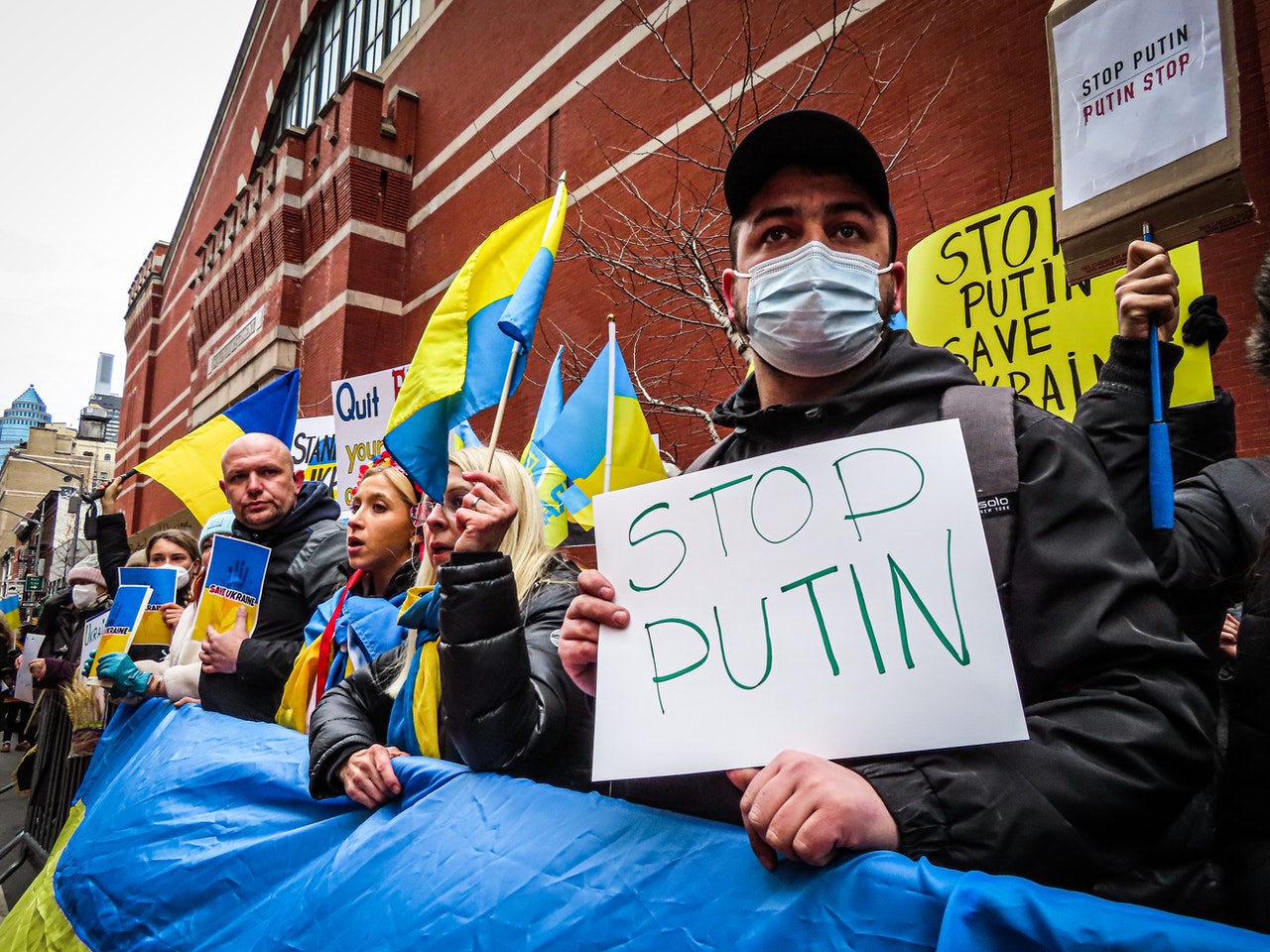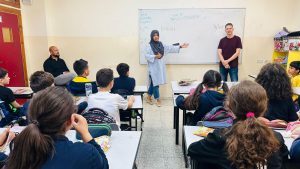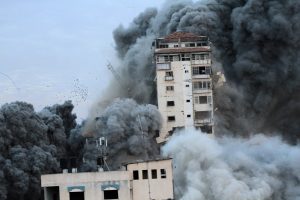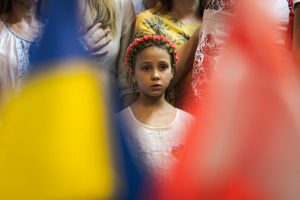Top image: Katie Godowski from Pexels
There is an old Malay proverb, “gajah sama gajah berjuang, pelanduk mati di tengah-tengah”—“when elephants fight each other, the mousedeer dies in the middle.” This adage describes the situation in Ukraine today. It is the result of a conflict between two great powers: the resurgent strength of Russia and the indomitable influence of the United States evidenced through years of NATO expansion.
Innocent Ukrainians are suffering, and many people have lost their lives. This is a tragic page in human history and, like many other tragedies, one that could have been avoided.
Many of us are led to conclude that the cause of the crisis in Ukraine today starts and ends with Russian President, Vladimir Putin. He is described as a sociopathic, irrational, and power-hungry dictator bent on conquering neighbouring countries to expand the Russian empire.
While not entirely false, this conclusion does not paint the complete picture.
Instead, let’s assume for a moment that Putin is a rational and shrewd authoritarian who sees the North Atlantic Treaty Organization or “NATO” expansion into Ukraine as an existential threat to his country.
The threat of NATO expansion
Three decades ago, the Cold War ended with the collapse of the Soviet Union and the United States becoming the sole great power on the planet. Since then, democratic and pro-West countries have mushroomed in Eastern Europe. In 1999, Poland, Hungary, and the Czech Republic joined NATO amid much debate within the organization and Russian opposition.
Another expansion came with the accession of seven Central and Eastern European countries: Bulgaria, Estonia, Latvia, Lithuania, Romania, Slovakia, and Slovenia.
Being part of NATO goes beyond receiving military defence assets from the United States and enjoying the benefit of collective defence from all NATO members if one member was attacked. To join NATO, nations must undergo a Membership Action Plan which involves democratic standards, internal political and military reforms, and guarantees of civil liberties. Through NATO, the U.S. remoulded the former Communist countries into their own image and entrenched its place at the top of the Western hierarchy.
While Russia opposed this wave of political and philosophical change, these changes were not an existential issue for the key remnant nation of the Soviet Union. The key concern for Russia is NATO military aid, which includes installations of missile systems described by NATO to be entirely defensive.
Even if such a defensive system lacked any offensive capabilities, these defences would neutralize Russia’s strike capabilities that it relies on to compensate for its inferior conventional military strength in relation to NATO and the United States.
De-escalating de-escalation
Tensions escalated when, at a summit in Bucharest in 2008, then-President Bush, despite contrary advice, pushed for NATO to eventually include Ukraine and Georgia, countries which share borders with Russia as NATO members. This push was resisted by Germany, France, and at least five other countries, as it would be an unnecessary offence to Russia and would upset efforts for missile de-escalation.
The U.S. insisted, and NATO issued a statement following the summit that they “agreed today that [Ukraine and Georgia] will become members of NATO.”
At the summit, Putin strongly rejected the plan to include Ukraine and Georgia into NATO as a “direct threat” to Russia’s security. Putin claimed that offensive missiles installed in Ukraine could hit Moscow within 10 minutes. There are no natural geological formations along the Russia-Ukraine border. In a way, they share the same backyard. From Luhansk near the southeast Ukraine border, forces can travel 750km to Volgograd and cut off Russia from the Black Sea.
It is hard not to recognize how missiles in Ukraine can mirror the Cuban Missile Crisis in the 1960s when the U.S. discovered plans by the Soviet Union to install offensive weapons (described as defensive only by the Soviets) in Cuba, which is some 300 km south of Florida.
Then, nuclear war was averted by intense diplomacy, mutual disarming of weapons (Soviet’s missiles in Cuba and the U.S.’ weapons in Italy and Turkey) and the crucial decision by commander Vasily Arkhipov to disagree with his captain on launching a nuclear torpedo from a Soviet submarine at the Cuban blockade line.
However, NATO reported that there were no NATO forces in the eastern part of the Alliance before 2014 and that the trigger for arms escalation was due to Russia’s illegal annexation of Crimea in 2014.
Developments in Ukraine since 2008
The tone at the 2008 Bucharest summit was open and cooperative. Putin was reported to even have said, “Let’s be friends, guys, and be frank and open.” However, over the years that followed, German chancellor Angela Merkel and U.S. President Barack Obama were criticized as being too conciliatory with Russia and in taking a cautious approach to NATO expansion, specifically in arming Ukraine.
Under Obama, the U.S. provided Ukraine with U.S. intelligence support, military training, and advice while imposing sanctions that hurt the Russian economy without causing it to collapse.
Unfortunately, things were not peaceful in Ukraine. The country is divided along pro-Russian and pro-West lines.
Viktor Yanukovych was elected Ukrainian President in 2010 and claimed to promote a balanced policy that will protect the interests of Russia while aligning with the European Union.
During his presidency, he was criticized for allegedly imprisoning his main opposition, controlling the media, restricting other civil liberties, and corruption and cronyism. He resigned in 2014 at the height of the Euromaidan protests when Ukrainian citizens demanded stronger integration with Europe in response to his building closer ties with Russia.
In the background, the U.S. claimed the Russians were involved in installing Yanukovych. At the same time, the Russians pointed at U.S. involvement in the protests that led to Yanukovych’s removal from office.
This triggered Putin to deploy forces to seize Crimea. This seizing of Crimea shocked Europe and triggered NATO to escalate defences in response. Why did Putin risk this?
When Yanukovych was removed, pro-Russian protests erupted in Crimea. The Crimean Peninsula is also home to a large part of the Russian navy. It is critical to its interests in the Black Sea.
The Eastern part of Ukraine, along the Russian border, called the Donbas region and made up of Donetsk and Luhansk, is also pro-Russian. Fighting erupted before parties arrived at a ceasefire Minsk accords.
Donetsk and Luhansk held elections in an attempt to exercise the international right to self-rule, to align itself with Russia. The elections were rejected by the Ukraine government in Kyiv and the U.S. as a Russian ploy.
Why now?
As recently as December 2021, the Russian Ministry of Foreign Affairs published a proposed draft of US-Russia and NATO-Russia agreements that encapsulate Moscow’s desired guarantees: for Ukraine to be barred from ever joining NATO and for NATO to cease expanding eastward.
The Biden administration dismissed any limits on NATO expansion as a non-starter and re-iterated that “all countries have the right to decide their own future and their own foreign policy, free from outside interference, and that goes for Ukraine and it also goes for NATO allies and the alliance itself.”
The draft had also called for NATO to remove troops and weapons from countries that joined NATO after 1997, for the U.S. and Russia to mutually refrain from deploying troops in areas where they could be perceived as a threat to each other and a ban on sending aircraft and warships into areas where they could strike each other’s territory.
These were rejected by NATO and the U.S. with some analysts describing Russia’s requests as “not serious”.
Following the annexation of Crimea in 2014, Ukraine has piled up its military might. In a few more years, and with the deployment of NATO assets, an invasion of Ukraine would not be feasible for Russia.
Russia is also Europe’s natural gas supplier, and energy costs are skyrocketing all over Europe due to a resurgent post-pandemic demand and supplies lagging behind. This might make Europe hesitate in any major reprisals. After all, why bite the hand that keeps you warm in winter?
Of all these countries, Germany is affected most. Germany wants to transition to renewables and has committed to shut down its nuclear plants. Natural gas is a big part of the transition, and Germany and Russia are on the precipice of commissioning the use of the recently constructed Nord Stream 2 project—a natural gas pipeline in the Baltic Sea connecting the two countries.
In the years that Angela Merkel was at the helm, Germany’s influence in Europe grew and often Merkel played a key role in bridging the interests of Europe and Russia. The Green Party, being part of Germany’s coalition government, now lead on foreign policy and climate policy—a key European nation finds itself between a rock and a hard place.
In the days leading up to the invasion on 24th February 2022, Germany sent Ukraine a field hospital and 5,000 helmets. Even Turkey sent predator drones, and Canada put boots on the ground. But since the actual invasion, Germany has decided that a “turning point” has been reached and has since approved the provision of military weapons to Ukraine.
Also, prior to the invasion, Russia’s ally, China, flew 39 warplanes into Taiwan’s air defence zone. Why? So that the U.S. will have to contend with possibly two major war theatres in two separate parts on the other side of the Earth.
Conveniently, Putin waited for China to be done with the Winter Olympics before initiating the invasion.
Possible next steps
No matter how justified, Putin is an aggressor and a transgressor of our rules-based international order. He threatened the world when he put his nuclear military capabilities on high alert. He did not need to attempt to invade Ukraine or threaten nuclear attacks and reprisals to concretize his message against NATO over-expansion.
At the risk of sounding unsympathetic to the plight of ordinary Ukrainians, it would have been enough for Russia to have supplied military support or even minor military intervention to pro-Russians in the Donbas region. Still, for reasons only known to him, he has escalated the situation close to the point of no return. His hands are stained with blood, and he is fulfilling the West’s caricature of him, thereby losing any credibility and goodwill on which negotiations and compromise rely, to the detriment of the Russian people.
As outsider nations, we should support sanctions on any nation that does not respect the borders of other nations. But sanctions alone, even the extreme move to cut off Russia from the SWIFT inter-bank system, may not resolve the issues underlying this crisis. Russia has been the target of crippling sanctions for almost a decade. The Russian people had to suffer through massive inflation while Putin moved the country away from relying on the U.S. dollar—not easy when its main exports of oil and gas are predominantly priced in U.S. dollars.
Still, these disincentives have had little effect on the country. Because, for Russia, it’s an existential issue and not about conquest or economics.
The USA, Ukraine and Russia should agree to a ceasefire and negotiate in good faith—despite how parties might feel about each other. Negotiations between Ukraine and Russia are ongoing. Hopefully, the talks conclude in a pull-back of Russian forces and also de-escalation of arms in NATO nations.
Will Russia agree to de-escalation? The U.S. and Russia agreed on New START, a mutual nuclear arms de-escalation treaty signed in 2010, which was extended as recently as 2021.
It is in the U.S.’ interest to roll back American spending on NATO defences. Reduced American intervention in the defence of European countries means they can no longer free ride and must step up defence spending and engage in more conciliatory diplomacy with their Eastern aggressor nation.
A new détente between Russia and Europe (with reduced influence from the U.S.) must arise. In truth, there’s no reason to fight. Russia is a willing supplier of oil and gas, and Europe is a willing buyer in its quest for renewable energies and development.
Lessons for smaller countries
At the risk of sounding like a broken record, sovereignty and defence cannot be taken for granted, especially for smaller countries. Smaller countries must have their own deterrent military capability and cannot be overly reliant on military intervention or protection from other countries, including the strongest country in the world.
Our defensive capabilities must extend to cyber security and economic resilience; cyber and economic warfare has become the preferred war theatres in the 21st century. The mousedeers of the world must make itself a force to be reckoned with.
We must maintain good relations with all neighbouring nations, especially those with great powers. Balance and compromise are necessary—leaders often must ride a populist wave to remain in power but domestic ambitions must be tempered by realpolitik. The people should recognize when unpopular but necessary decisions must be accepted.
Ukraine, and other nations, can take the example of Finland and Sweden, countries with a history of conflict with the Russian empire and the Soviet Union. They have a long-standing policy of neutrality, referred to as “Finlandization”, under which they continue to refuse to be a part of NATO despite being members of the European Union, having strong military and research partnerships with NATO countries and the United States, and even supporting other Eastern European countries to join NATO (without joining themselves).
Being outside of NATO, Finland and Sweden continued to build up their military capabilities while other countries let their guard down as NATO recipients of significant military spending. This delicate balance has allowed these countries to achieve economic growth and security.
Despite its vulnerability to abuse by great powers or rogue militarily strong nations, we all should continue to support and advocate for the rules-based international order—which protects the interest of smaller nations. While we have no better alternatives, we should aspire to improve the system.
This means that, from time to time, nations may have to band together and call out the great powers, including China and the U.S., when they act contrary to international law or abuse their positions such as the U.S.’ veto against reprisals to illegal actions in occupied Palestine or confronting China effectively for their treatment of Uighurs in Xinjiang.
We should also enforce sanctions against countries that breach the rules, like Russia. Like the United Nations, our global institutions have little choice but to evolve and adapt to the new multi-polar world.







